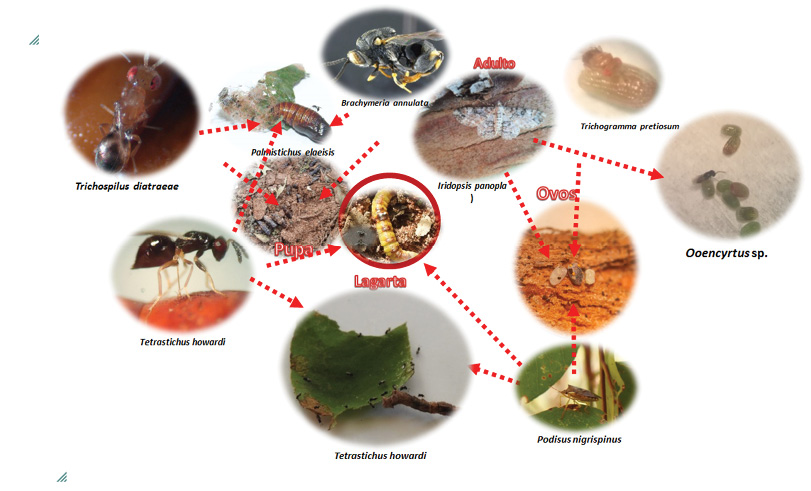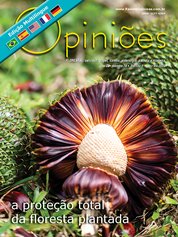Fabricio Fagundes Pereira
Professor de Entomologia da UF-Grande Dourados-MS
OpCP70
Controle biológico de lagartas desfolhadoras
O setor florestal tem contribuído significativamente para o desenvolvimento econômico e social de Mato Grosso do Sul. A ampliação das áreas de florestas plantadas, com cerca de 1.124.637 hectares, e a chegada de indústrias da área geraram milhares de empregos e transformaram definitivamente a costa leste do estado. Dentre os entraves que podem comprometer a produtividade de essências florestais, destacam-se os insetos-praga, as doenças e as plantas daninhas. Lagartas desfolhadoras, principalmente Iridopsis panopla e Thyrinteira arnobia são pragas que, nos últimos anos, têm alcançado níveis populacionais elevados, especialmente na cultura do eucalipto, em áreas produtoras situadas na mesorregião leste de Mato Grosso do Sul. A ocorrência associada desses lepidópteros desfolhadores e seus danos, no ano de 2021, de acordo com o monitoramento realizado por silvicultores, foi registrada em cerca de 681.886 hectares, cultivados com eucalipto, ocorrendo durante todo o ano, com maior predomínio entre janeiro e julho, devido a vários fatores, entre eles, as condições climáticas favoráveis e que são diferentes a cada ano.
Em 2022, a ocorrência de lepidópteros desfolhadores nos plantios de eucalipto foi relatada em 233.816 hectares. A cada ano, existe uma variação na flutuação populacional de lepidópteros desfolhadores e, por isso, a implementação do plano de monitoramento e adoção de medidas emergenciais de controle são imprescindíveis para se evitarem os efeitos negativos decorrentes dos danos ocasionados pelas pragas mencionadas, que podem surpreender os silvicultores, com surtos populacionais e prejuízos econômicos e ambientais imensuráveis durante todo o ano. Percebe-se que o aumento da população de lepidópteros pode ocorrer a partir de janeiro, com picos populacionais em maio, no Mato Grosso do Sul. Existem produtos biológicos à base de Bacillus thuringiensis e químicos registrados no Ministério da Agricultura e Abastecimento (MAPA) para Thyrinteira arnobia, mas, nos últimos anos, surtos populacionais de Iridopsis panopla e seus danos têm preocupado os silvicultores. Trata-se de uma praga nova, com elevado potencial biótico, grande capacidade de desfolha e, em adição, não há informações básicas e produtos registrados para seu controle.
Palmistichus elaesis, Trichospilus diatraeae, Tetrastichus howardi são parasitoides, principalmente de pupas de lepidópteros que ocorrem de cultivos agrícolas e florestais. Temos trabalhado com esses agentes de controle biológico há mais de 20 anos. Nos últimos 5 anos, o grupo de pesquisa de Controle Biológico de Insetos, da Universidade Federal da Grande Dourados, em parceria com a Reflore-MS – Associação dos Produtores e Consumidores de Florestas Plantadas, o MAPA e a Startup Sistêmica Kovê, empresa de controle biológico fundada por estudantes e incubada na UFGD, com apoio do CNPq, Fundect e Capes, por meio ações de pesquisa, gerou resultados para que as especificações de referências fossem publicadas.
Isso implicou novos bioinsumos, Palmistichus elaeisis, Trichospilus diatraeae, Tetrastichus howardi, para controle de lepidópteros desfolhadores em eucalipto. Em paralelo, descobrimos que, naturalmente, a microvespa Trichogramma pretiosum parasita ovos de I. panopla. Desde então, estamos trabalhando para validar a eficiência desse inimigo natural para que seja utilizado como novo bioinsumo no controle biológico dessa lagarta.
É importante destacar que reuniões mensais entre associados e técnicos de empresas do setor florestal têm sido realizadas para atualização das áreas monitoradas, infestadas e controladas, inclusive com outros produtores da região, para se adotarem ações uniformes e conjuntas com base nos princípios do manejo integrado de pragas e nas boas práticas agronômicas. As empresas associadas à Reflore-MS investem em uma equipe robusta de monitores para identificação precoce de pragas e doenças em sua base florestal. Os esforços para conter o avanço de lepidópteros desfolhadores vão desde a soltura de insetos parasitoides e predadores com produção on farm até o uso de microbiológicos, como fungos e bactérias entomopatogênicas.
Mas, além dos custos com os controles, existem perdas produtivas causadas pela desfolha, que variam de 10 a 40 % de redução no volume de madeira de eucalipto na idade de corte (entre 6 e 7 anos). O Prof. Carlos Frederico Wilcken da Unesp, profissional com expertise na área, enfatiza ainda que essa variação depende da intensidade do desfolhamento (parcial a total), número de desfolhas e do material genético (clones ou espécies) de eucalipto plantado. Devido ao surto em 2021, estima-se que o setor do eucalipto no Mato Grosso do Sul deixou de colher 35.225.475 m³ de madeira. E isso representou uma perda de R$ 1.761.273.78,00.
Nesse contexto, órgãos governamentais, silvicultores, técnicos e pesquisadores do setor florestal chegaram a um consenso de que há necessidade de se elaborar um programa estadual de sanidade florestal, e chamam a atenção para várias diretrizes, entre elas, podem-se destacar: o estabelecimento de rede de informações para unificação da tomada de decisão no controle das pragas, doenças e plantas, especialmente coleópteros desfolhadores, cupins de solo, formigas cortadeiras, grilos, lepidópteros (lagartas desfolhadoras), percevejo-bronzeado, psilídeo-de-concha e vespa-da-galha, que estão entre os grupos de insetos que podem ser nocivos às plantações florestais, especialmente de eucalipto no Mato Grosso do Sul; a criação de um sistema de alerta fitossanitário para as “lagartas desfolhadoras” (Iridopsis panopla e Thyrinteina arnobia) no MS, como ferramenta auxiliar aos silvicultores, para monitoramento e divulgação das condições favoráveis à incidência das lagartas desfolhadoras do eucalipto, visando à tomada de decisão sobre a implementação de procedimentos de manejo, mitigando danos e prejuízos locais e promovendo, regionalmente, a manutenção do nível populacional da praga sob controle; o estabelecimento de critérios de manejo das populações de lagartas em áreas de eucalipto a 250 metros de mananciais de água; a determinação e a seleção de espécies/clones mais resistentes à I. panopla; o controle de pequenos focos (até 100 hectares) para evitar a disseminação das pragas para áreas maiores e vizinhas; a importância de se correlacionar ocorrência, danos, medidas de controle e custos ao longo de todo o ciclo da cultura, considerando talhões e área total da fazenda, bem como sua receita líquida; a prioridade a pesquisas e registros de produtos biológicos e sintéticos seletivos a inimigos naturais para controle de pragas, doenças e plantas daninhas; o fomento para instalação de biofábricas para a produção local de agentes de controle biológico de pragas; e, enfim, o incentivo à promoção de parcerias público-privada (prefeituras municipais, instituições de ensino e pesquisa, associações de produtores e empresas do setor), visando gerar e difundir informações e alternativas para monitoramento e manejo sustentável de lagartas desfolhadoras de eucalipto.





